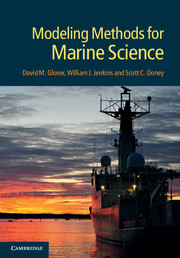Book contents
- Frontmatter
- Contents
- Preface
- 1 Resources, MATLAB primer, and introduction to linear algebra
- 2 Measurement theory, probability distributions, error propagation and analysis
- 3 Least squares and regression techniques, goodness of fit and tests, and nonlinear least squares techniques
- 4 Principal component and factor analysis
- 5 Sequence analysis I: uniform series, cross- and autocorrelation, and Fourier transforms
- 6 Sequence analysis II: optimal filtering and spectral analysis
- 7 Gridding, objective mapping, and kriging
- 8 Integration of ODEs and 0D (box) models
- 9 A model building tutorial
- 10 Model analysis and optimization
- 11 Advection–diffusion equations and turbulence
- 12 Finite difference techniques
- 13 Open ocean 1D advection–diffusion models
- 14 One-dimensional models in sedimentary systems
- 15 Upper ocean 1D seasonal models
- 16 Two-dimensional gyre models
- 17 Three-dimensional general circulation models (GCMs)
- 18 Inverse methods and assimilation techniques
- 19 Scientific visualization
- Appendix A Hints and tricks
- References
- Index
14 - One-dimensional models in sedimentary systems
Published online by Cambridge University Press: 05 June 2012
- Frontmatter
- Contents
- Preface
- 1 Resources, MATLAB primer, and introduction to linear algebra
- 2 Measurement theory, probability distributions, error propagation and analysis
- 3 Least squares and regression techniques, goodness of fit and tests, and nonlinear least squares techniques
- 4 Principal component and factor analysis
- 5 Sequence analysis I: uniform series, cross- and autocorrelation, and Fourier transforms
- 6 Sequence analysis II: optimal filtering and spectral analysis
- 7 Gridding, objective mapping, and kriging
- 8 Integration of ODEs and 0D (box) models
- 9 A model building tutorial
- 10 Model analysis and optimization
- 11 Advection–diffusion equations and turbulence
- 12 Finite difference techniques
- 13 Open ocean 1D advection–diffusion models
- 14 One-dimensional models in sedimentary systems
- 15 Upper ocean 1D seasonal models
- 16 Two-dimensional gyre models
- 17 Three-dimensional general circulation models (GCMs)
- 18 Inverse methods and assimilation techniques
- 19 Scientific visualization
- Appendix A Hints and tricks
- References
- Index
Summary
My own brain is to me the most unaccountable of machinery – always buzzing, humming, soaring roaring diving, and then buried in mud.
Virginia WoolfWe treat one-dimensional models of sedimentary systems separately in this book because of the added complication that they contain two phases – solid material and pore waters – that not only can interact biogeochemically, exchanging chemicals, but also can move in relation to one another. In fact, with a reference system fixed at the sediment–water interface, the solid phase is actually moving owing to a combination of sedimentation (addition of material at the interface) and compaction. If you're thinking that this makes the construction of models a little more complicated, those are exactly our sediments!
We will be talking about the process of diagenesis, i.e. the sum total of all processes that bring about changes to sediments after they have been deposited on the seafloor. This includes everything from bioturbation through chemical transformation to compaction and pore water extrusion. The general topic of diagenesis extends to even longer timescale processes that include metamorphism and weathering of sedimentary rocks after uplift, but we will focus on Early Diagenesis (Berner, 1980), which encompasses changes that occur at or near the sedimentary surface or in the upper portion of the sedimentary column.
- Type
- Chapter
- Information
- Modeling Methods for Marine Science , pp. 346 - 364Publisher: Cambridge University PressPrint publication year: 2011



